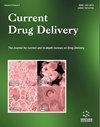三种介孔二氧化硅微球的快速合成及其缓释性能。
IF 2.8
4区 医学
Q2 PHARMACOLOGY & PHARMACY
引用次数: 0
摘要
背景:介孔二氧化硅纳米颗粒(MSNs)是最有前途的药物递送载体之一。微孔微球具有孔径大、比表面积大、生物相容性好、无毒、易于功能化、缓释等优点,被广泛用于药物载体的研究。微微颗粒由于其特殊的结构在给药过程中受到了广泛的关注。目的:采用简便的方法合成介孔二氧化硅纳米颗粒(MSNs)、树突状介孔二氧化硅纳米颗粒(dpmsn)和中空介孔二氧化硅纳米颗粒(HMSN),并比较不同孔结构的纳米多孔二氧化硅作为PUE药物基质的释药性能。方法:采用SEM、TEM、FT-IR、氮气吸附-脱附等温线、XRD、zeta电位等方法对其进行表征。随后,以葛根素(PUE)为活性成分,分别加载到三种介孔材料中。并在不同pH值的PBS溶液中测定其给药行为。研究了负载PUE的MSN、DMSN和HMSN的缓释性能。最后,采用MTT法和溶血法研究了MSN、DMSN和HMSN的生物相容性和稳定性。结果:成功合成了MSN、dmmsn和HMSN,三种介孔二氧化硅纳米颗粒均具有较高的载药量和包封效率。根据一阶释放方程曲线和Higuchi方程参数,结果表明,负载pue的MSN、DMSN和HMSN均具有缓释特性。最后,MTT和溶血实验表明,MSN、DMSN和HMSN具有良好的生物相容性和稳定性。结论:本研究成功合成了MSN、dmmsn和HMSN,比较了不同孔结构的纳米多孔二氧化硅作为PUE药物基质的药物释放性能,为PUE的应用提供了理论和实践依据。本文章由计算机程序翻译,如有差异,请以英文原文为准。
Facile Synthesis of Three Types of Mesoporous Silica Microspheres as Drug Delivery Carriers and their Sustained-Release Properties.
BACKGROUND
Mesoporous silica nanoparticles (MSN) are one of the most promising carriers for drug delivery. MSNs have been widely used in pharmaceutical research as drug carriers because of their large pore volume, high surface area, excellent biocompatibility, nontoxicity, ease to functionalize, and sustained release effects. MSNs have attracted much attention during drug delivery because of their special structure.
OBJECTIVE
The present study aimed to synthesize mesoporous silica nanoparticles (MSN), dendritic mesoporous silica nanoparticles (DMSN) and hollow mesoporous silica nanoparticles (HMSN) through facile methods, and to compare the drug release properties of nano-porous silica with different pore structures as a stroma for PUE drug.
METHODS
MSN, DMSN, and HMSN were characterized by SEM, TEM, FT-IR, nitrogen adsorption-desorption isotherms, XRD, and zeta potential methods. Subsequently, puerarin (PUE) was used as the active ingredient and loaded into the three mesoporous materials, respectively. And the drug delivery behavior was measured in PBS solution with different pH values. The sustained-release properties of MSN, DMSN, and HMSN loaded with PUE were investigated. Finally, the biocompatibility and stability of MSN, DMSN, and HMSN were studied by MTT assay and hemolysis assay.
RESULTS
Our results showed that MSN, DMSN, and HMSN were successfully synthesized and the three types of mesoporous silica nanoparticles had higher drug loading and encapsulation efficiency. According to the first-order release equation curve and Higuchi equation parameters, the results showed that the PUE-loaded MSN, DMSN, and HMSN exhibited sustained-release properties. Finally, MTT and hemolysis methods displayed that MSN, DMSN, and HMSN had good biocompatibility and stability.
CONCLUSION
In this study, MSN, DMSN, and HMSN were successfully synthesized, and to compare the drug release properties of nano-porous silica with different pore structures as a stroma for PUE drug, we provided a theoretical and practical basis for the application of PUE.
求助全文
通过发布文献求助,成功后即可免费获取论文全文。
去求助
来源期刊

Current drug delivery
PHARMACOLOGY & PHARMACY-
CiteScore
5.10
自引率
4.20%
发文量
170
期刊介绍:
Current Drug Delivery aims to publish peer-reviewed articles, research articles, short and in-depth reviews, and drug clinical trials studies in the rapidly developing field of drug delivery. Modern drug research aims to build delivery properties of a drug at the design phase, however in many cases this idea cannot be met and the development of delivery systems becomes as important as the development of the drugs themselves.
The journal aims to cover the latest outstanding developments in drug and vaccine delivery employing physical, physico-chemical and chemical methods. The drugs include a wide range of bioactive compounds from simple pharmaceuticals to peptides, proteins, nucleotides, nucleosides and sugars. The journal will also report progress in the fields of transport routes and mechanisms including efflux proteins and multi-drug resistance.
The journal is essential for all pharmaceutical scientists involved in drug design, development and delivery.
 求助内容:
求助内容: 应助结果提醒方式:
应助结果提醒方式:


